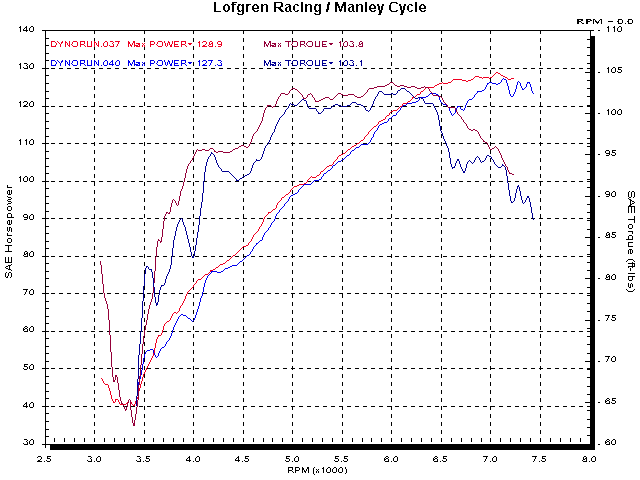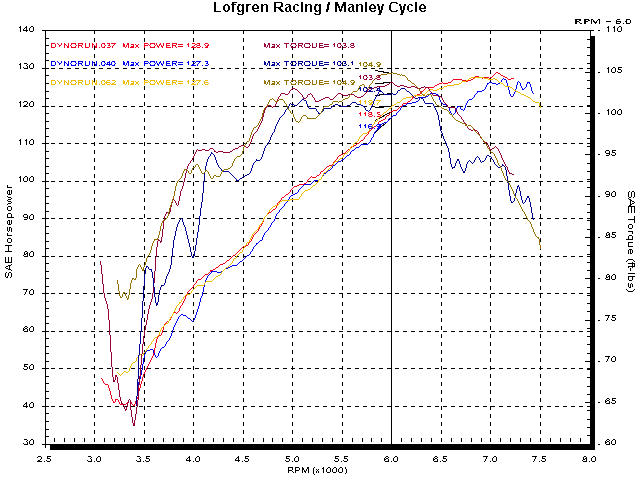
Final Testing for the 2001 Riding Season
The day after our last round of WOT tests we came back (on a Sunday, in January) to finish the part throttle carburation.
In the process of getting the necessary throttle response from idle to WOT, we had added, first, one extra off idle hole, to the intermediate circuit, then one more, for a total of 5.
When we began testing on Sunday, I noticed that the idle air/fuel ratio was sometimes very lean and sometimes OK. After very little investigation we came to the conclusion that we had introduced too much air bleed to the intermediate circuit.
A little explanation is in order here.
The 'intermediate' circuit of an S&S carb is the same as the pilot circuit of a Keihin or Mikuni CV carb.
The 'butterfly' throttle, because one side swings toward the atmospheric side of the carb, allows an excellent transition from idle to the point where the main circuit starts. In the pilot circuit there is one fuel jet, one idle fuel port, several off-idle ports, and a permanent air bleed. At idle, fuel mixture is dispensed thru the idle port and adjusted with the idle mixture screw. Also at idle, the off-idle ports are on the atmospheric side of the throttle blade. Together with the fixed air-bleed they constitute the total air-bleed for the circuit at idle.
Air-bleeds are often referred to as vacuum breaks. This is a very descriptive nomenclature because they actually decrease or 'break' the vacuum felt at the fuel jet.
As the throttle is opened, the edge of the 'butterfly' passes over the off-idle ports progressively, converting each port from a vacuum break to a fuel dispensing port as it passes. By the time the butterfly is past all of the off-idle ports, there is much less vacuum break and many more fuel dispensers.
In the case of Michael's Buell, as we extended the intermediate circuit we introduced two more vacuum breaks at idle. This made the idle fuel control unstable.
I called a halt to that day's testing and Mike took the carbs home to re-work them.
In April, we decided to get the Buell going (so Mike or anyone else who's interested, can actually ride it.)
Michael filled in the off-idle ports and re-drilled four holes out to the same distance as the previous five.
In our last round of testing we shortened the inlet by 1/2" by removing the filter backing plate (sandwiched between the carb body and the radiused inlet piece.) We also wanted to see if we could get a little more power by removing the filter.
There was no surprise that the air/fuel mixture leaned a little because we removed the filter, but thru the torque peak the A/F was actually better without the filter and the extra length. Up at 6600 RPM the mixture did go lean enough to cause the mis-fire seen in the chart below.
In spite of the improved A/F ratio, the torque dropped. Run # 40 is the shorter inlet length.

Because of this result, Michael decided to come back to the dyno with an extra 1/2" spacer. Although the differences are subtle they are repeatable, and we decided that we liked the slight increase in torque and the sharper drop-off above 7000 RPM.

In previous reports we have shown 5th gear runs. The inertia is lower in 5th gear and the power numbers are usually a little higher.
Also, we have cooled the top-end of the engine a little to optimize the volumetric efficiency.
In our last series of runs and in this report I have used 4th gear runs only. We could probably increase the jet sizes and cool the top-end and try a 5th gear run and get a few more 'ponies'. (You might have noticed that there aren't any 130 HP runs in this report.)
My feeling is that this represents the best configuration we've had and this thing will 'kill' a Ducati 996 out on the road.
We took the bike up to Brainerd during the first CRA race of the season, and Jurgen Gassebner, editor of PS magazine in Germany, decided to do an article on it. Needless to say, we are thrilled, and hope that some American magazines will be able to test it.